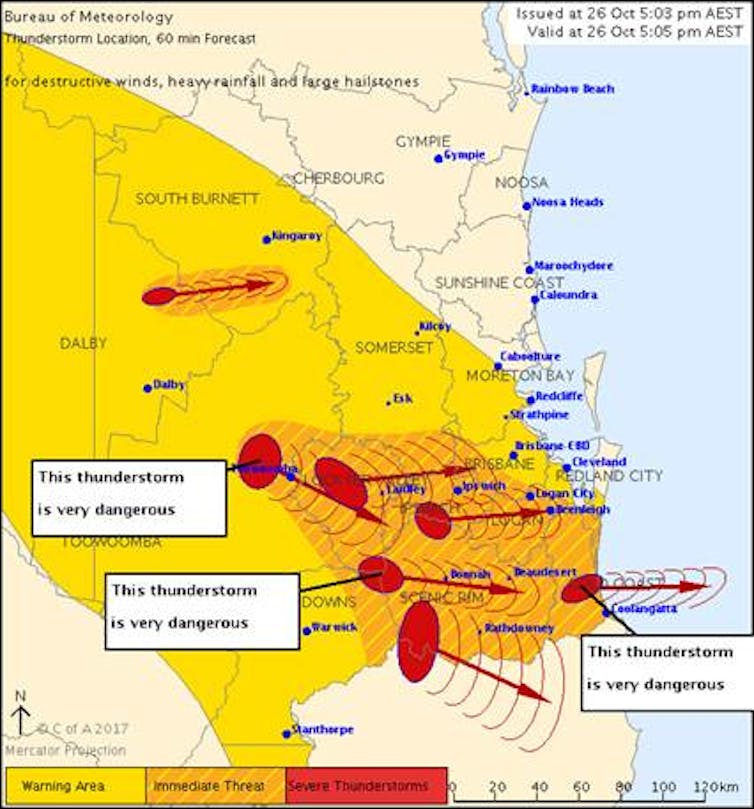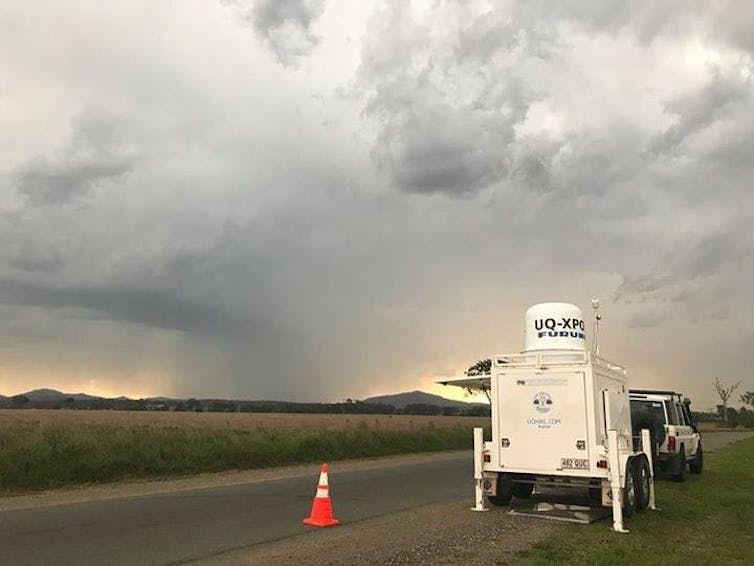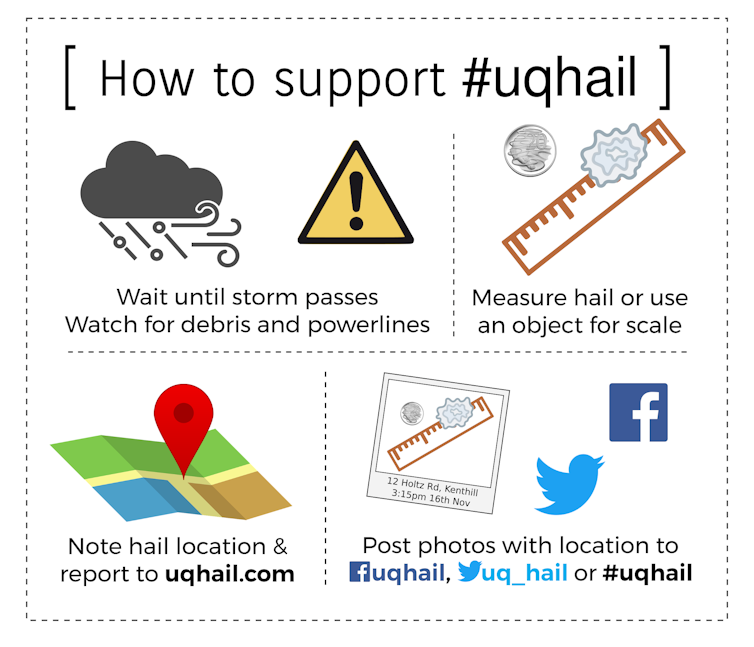All hail new weather radar technology, which can spot hailstones lurking in thunderstorms
- Written by Joshua Soderholm, Research scientist, The University of Queensland
An Australian spring wouldn’t be complete without thunderstorms and a visit to the Australian Bureau of Meteorology’s weather radar website. But a new type of radar technology is aiming to make weather radar even more useful, by helping to identify those storms that are packing hailstones.
Most storms just bring rain, lightning and thunder. But others can produce hazards including destructive flash flooding, winds, large hail, and even the occasional tornado. For these potentially dangerous storms, the Bureau issues severe thunderstorm warnings.
For metropolitan regions, warnings identify severe storm cells and their likely path and hazards. They provide a predictive “nowcast”, such as forecasts up to three hours before impact for suburbs that are in harm’s way.
Read more: To understand how storms batter Australia, we need a fresh deluge of data
When monitoring thunderstorms, weather radar is the primary tool for forecasters. Weather radar scans the atmosphere at multiple levels, building a 3D picture of thunderstorms, with a 2D version shown on the bureau’s website.
This is particularly important for hail, which forms several kilometres above ground in towering storms where temperatures are well below freezing.
 Bureau of Meteorology 60-minute nowcast showing location and projected track of severe thunderstorms in 10-minute steps.
Australian Bureau of Meteorology
Bureau of Meteorology 60-minute nowcast showing location and projected track of severe thunderstorms in 10-minute steps.
Australian Bureau of Meteorology
In terms of insured losses, hailstorms have caused more insured losses than any other type of severe weather events in Australia. Brisbane’s November 2014 hailstorms cost an estimated A$1.41 billion, while Sydney’s April 1999 hailstorm, at A$4.3 billion, remains the nation’s most costly natural disaster.
Nonetheless, accurately detecting and estimating hail size from weather radar remains a challenge for scientists. This challenge stems from the diversity of hail. Hailstones can be large or small, densely or sparsely distributed, mixed with rain, or any combination of the above.
Conventional radars measure the scattering of the radar beams as they pass through precipitation. However, a few large hailstones can look the same as lots of small ones, making it hard to determine hailstones’ size.
A new type of radar technology called “dual-polarisation” or “dual-pol” can solve this problem. Rather than using a single radar beam, dual-pol uses two simultaneous beams aligned horizontally and vertically. When these beams scatter off precipitation, they provide relative measures of horizontal and vertical size.
Therefore, an observer can see the difference between flatter shapes of rain droplets and the rounder shapes of hailstones. Dual-pol can also more accurately measure the size and density of rain droplets, and whether it’s a mixture or just rain.
Together, these capabilities mean that dual-pol is a game-changer for hail detection, size estimation and nowcasting.
Dual-pol information is now streaming from the recently upgraded operational radars in Adelaide, Melbourne, Sydney and Brisbane. It allows forecasters to detect hail earlier and with more confidence.
However, more work is needed to accurately estimate hail size using dual-pol. The ideal place for such research is undoubtedly southeast Queensland, the hail capital of the east coast.
When it comes to thunderstorm hazards, nothing is closer to reality than scientific observations from within the storm. In the past, this approach was considered too costly, risky and demanding. Instead, researchers resorted to models or historical reports.
The Atmospheric Observations Research Group at the University of Queensland (UQ) has developed a unique capacity in Australia to deploy mobile weather instrumentation for severe weather research. In partnership with the UQ Wind Research Laboratory, Guy Carpenter and staff in the Bureau of Meteorology’s Brisbane office, the Storms Hazards Testbed has been established to advance the nowcasting of hail and wind hazards.
Over the next two to three years, the testbed will take a mobile weather radar, meteorological balloons, wind measurement towers and hail size sensors into and around severe thunderstorms. Data from these instruments provide high-resolution case studies and ground-truth verification data for hazards observed by the Bureau’s dual-pol radar.
Since the start of October, we have intercepted and sampled five hailstorms. If you see a convoy of UQ vehicles heading for ominous dark clouds, head in the opposite direction and follow us on Facebook instead.
 UQ mobile radar deployed for thunderstorm monitoring.
Kathryn Turner
UQ mobile radar deployed for thunderstorm monitoring.
Kathryn Turner
Unfortunately, the UQ storm-chasing team can’t get to every severe thunderstorm, so we need your help! The project needs citizen scientists in southeast Queensland to report hail through #UQhail. Keep a ruler or object for scale (coins are great) handy and, when a hailstorm has safely passed, measure the largest hailstone.
Submit reports via uqhail.com, email, Facebook or Twitter. We greatly appreciate photos with a ruler or reference object and approximate location of the hail.
 How to report for uqhail.
How to report for uqhail.
Combining measurements, hail reports and the Bureau of Meteorology’s dual-pol weather radar data, we are working towards developing algorithms that will allow hail to be forecast more accurately. This will provide greater confidence in warnings and those vital extra few minutes when cars can be moved out of harm’s way, reducing the impact of storms.
Read more: Tropical thunderstorms are set to grow stronger as the world warms
Advanced techniques developed from storm-chasing and citizen science data will be applied across the Australian dual-pol radar network in Sydney, Melbourne and Adelaide.
Who knows, in the future if the Bureau’s weather radar shows a thunderstorm heading your way, your reports might even have helped to develop that forecast.
This article was co-authored by Harald Richter, a senior research scientist with the Bureau of Meteorology’s Weather and Environmental Prediction Program.
Authors: Joshua Soderholm, Research scientist, The University of Queensland



